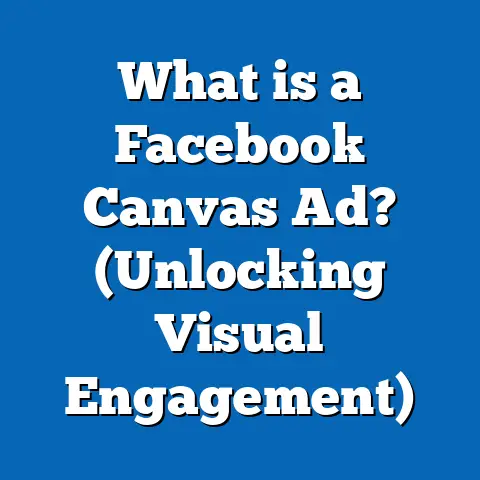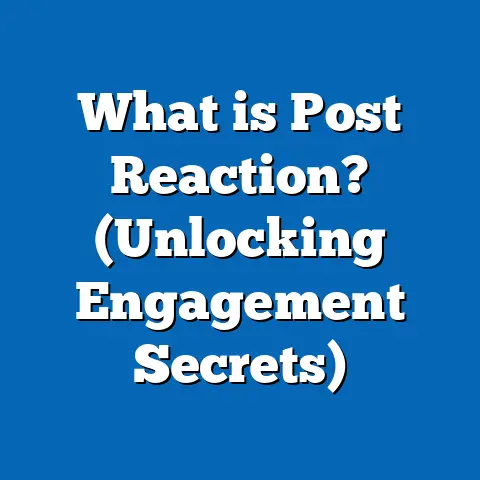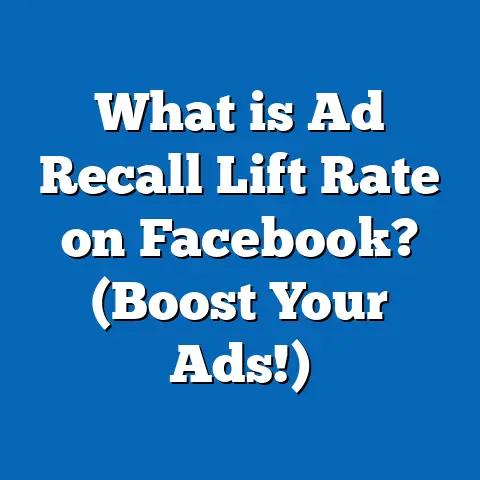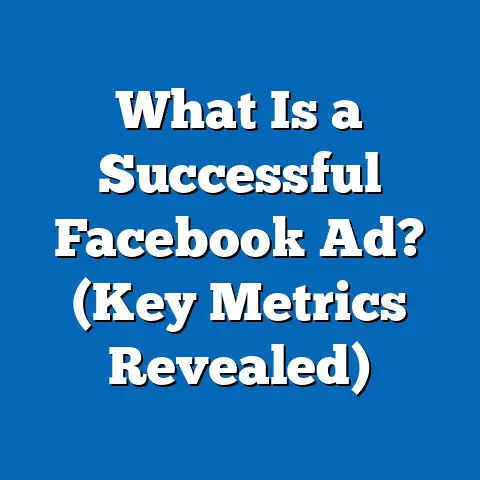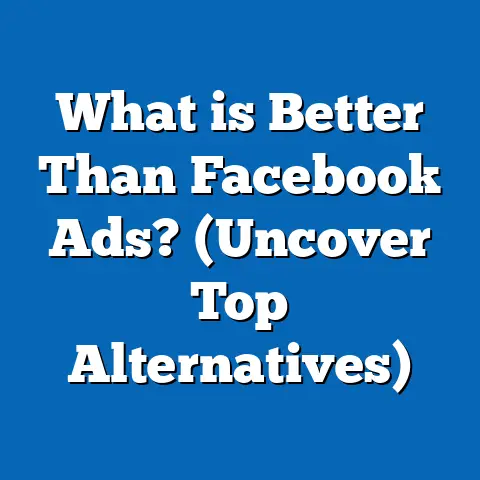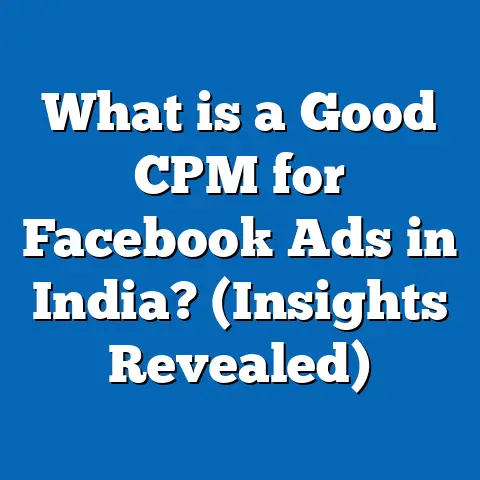What is a Facebook Collection Ad? (Maximize Engagement!)
What is a Facebook Collection Ad? (Maximize Engagement!)
Introduction: The Paradox of Facebook Ads
Facebook ads are everywhere—yet millions of businesses still struggle to capture meaningful engagement and conversions. How can an advertising platform with billions of users fail to deliver consistent results for so many? This paradox stems from the overwhelming volume of content flooding users’ feeds every second, making it harder than ever to grab attention and convert interest into action.
Facebook Collection Ads offer a solution to this challenge by combining immersive storytelling with a seamless shopping experience. This ad format allows brands to showcase multiple products in one ad, wrapped in a visually rich, mobile-first environment designed to keep users engaged longer and drive more sales.
Understanding Facebook Collection Ads
What is a Facebook Collection Ad?
A Facebook Collection Ad is a mobile-only ad format that combines a compelling cover image or video with a grid of product images pulled from your product catalog. When users tap the ad, it opens into an Instant Experience (previously known as Canvas)—a full-screen, fast-loading landing page within Facebook where users can browse additional products, interact with multimedia content, and make purchases without leaving the platform.
This format blends visual storytelling with product discovery in one seamless experience. It’s designed to reduce friction by keeping users inside the Facebook environment while providing rich information and easy access to your products.
Anatomy of a Facebook Collection Ad
Facebook Collection Ads consist of two main parts:
- Cover Media: A static image or video that grabs attention immediately. This is what users see first in their newsfeed.
- Product Tiles: A grid (usually 4 or more) of product images underneath the cover media, each clickable to take the user further into the Instant Experience or product page.
When clicked, the ad expands into an Instant Experience—a full-screen immersive page that can include:
- More product images
- Videos
- Text descriptions
- Buttons for purchase or lead capture
- Links to other pages or apps
Key Features That Make Collection Ads Unique
- Optimized for Mobile: Over 98% of Facebook users access the platform via mobile devices. Collection Ads leverage this by being mobile-first, ensuring fast load times and smooth navigation.
- Instant Experience: This proprietary full-screen format loads up to 15 times faster than traditional mobile sites, reducing drop-offs and increasing engagement.
- Rich Storytelling: Unlike traditional ads that show a single product or message, Collection Ads allow brands to tell a story using multiple products paired with lifestyle images or videos.
- Seamless Shopping: Users can browse products and complete purchases without leaving Facebook or Instagram, reducing friction in the buying process.
- Customizable Layouts: Several templates allow brands to showcase products in ways that align with their campaign goals—whether driving brand awareness, product discovery, or direct sales.
Why Collection Ads Matter in Today’s Advertising Landscape
In 2024, mobile commerce continues to dominate. According to eMarketer, mobile accounts for over 73% of total e-commerce sales worldwide. Consumers increasingly expect fast, immersive experiences that combine discovery and purchase seamlessly.
Key statistics supporting the impact of Facebook Collection Ads:
- Facebook reports that advertisers using Collection Ads see up to 30% higher conversion rates compared to standard static ads.
- Instant Experience pages have an average engagement time 20% longer than typical landing pages.
- Click-through rates (CTR) on Collection Ads are up to 3 times higher than carousel ads.
- Brands leveraging Collection Ads report a reduction in cost per acquisition (CPA) by 15-25% due to improved user flow and engagement.
How Facebook Collection Ads Work: Detailed Breakdown
Step 1: Building and Managing Your Product Catalog
A properly structured and maintained product catalog is foundational for successful Collection Ads. It houses all your inventory data that Facebook uses dynamically within your ads.
What is a Product Catalog?
A product catalog is a digital database that contains detailed information for every item you want to advertise or sell on Facebook. This includes:
- Product titles and descriptions
- High-quality images
- Prices and availability
- URLs linking to product pages on your website
- Unique identifiers like SKU or ID numbers
How to Set Up Your Product Catalog
You can create or upload catalogs in several ways:
- Manual CSV file upload: Upload spreadsheet files with product data.
- E-commerce platform integrations: Automatically sync your Shopify, BigCommerce, WooCommerce, Magento, or similar store’s inventory with Facebook Catalog Manager.
- Facebook Pixel & API: Connect via Facebook pixel tracking or API for real-time updates on inventory changes and pricing.
Best Practices for Catalog Management
- Keep your catalog updated daily or in near-real-time to avoid showing out-of-stock products.
- Use high-resolution images (at least 600×600 pixels) for clarity.
- Write concise but informative product descriptions emphasizing key benefits.
- Categorize products logically to improve targeting and dynamic ad relevance.
Step 2: Crafting Your Ad Creative
The creative elements form the emotional hook of your ad and influence whether users engage.
Cover Media: Image vs. Video
- Video covers tend to outperform static images by capturing attention more effectively. Short videos under 15 seconds work best.
- Use lifestyle footage showing the product in use rather than just isolated shots.
- Ensure branding is clear but not overwhelming—focus on storytelling first.
Product Tiles: Curating Your Selection
- Choose 4–6 products that match your campaign’s theme or user interests.
- Highlight best sellers, new arrivals, or items relevant to current promotions.
- Maintain image consistency in style and background for a harmonious look.
Copywriting Tips
- Use concise headlines focusing on benefits or emotional triggers (“Feel confident every day”).
- Add clear calls-to-action (CTAs) like “Shop Now” or “Discover More.”
- Avoid jargon; keep language simple and direct.
Step 3: Selecting the Optimal Template
Facebook offers different templates designed for specific goals:
| Template Name | Best Use Case | Description |
|---|---|---|
| Instant Storefront | E-commerce brands wanting product showcase | Display multiple products in a grid with easy navigation |
| Lookbook | Fashion, lifestyle brands | Combines lifestyle images/videos with product tiles |
| Customer Acquisition | Lead generation or new customer targeting | Emphasizes product benefits with engaging videos/images |
Choosing the right template impacts user experience and campaign success.
Step 4: Audience Targeting Strategies
Audience targeting determines who sees your ads. Facebook offers advanced tools:
Custom Audiences
Target people who have interacted with your business before:
- Website visitors (via Facebook Pixel)
- App users
- Email lists (uploaded securely)
Custom Audiences are powerful for retargeting warm leads more likely to convert.
Lookalike Audiences
Create audiences resembling your best customers based on behavior and demographics. This helps scale campaigns beyond existing contacts without losing relevance.
Broad Targeting
Use demographic filters like age, gender, location combined with interest-based targeting for brand awareness campaigns.
Step 5: Launching and Optimizing Your Campaign
Once set up:
- Monitor key metrics daily: CTR, conversion rate, cost per result.
- Use A/B testing on cover media and product tiles.
- Adjust bids and budgets based on performance.
Facebook’s algorithm will optimize ad delivery based on engagement signals over time.
Data-Backed Insights on Effectiveness of Facebook Collection Ads
Engagement Metrics That Matter
Several independent studies validate Collection Ads’ effectiveness:
| Metric | Improvement Over Standard Ads |
|---|---|
| Click-through rate (CTR) | Up to 3x higher |
| Time spent on Instant Experience | 20% longer than normal landing pages |
| Conversion rate | Up to 30% increase |
| Cost per acquisition (CPA) | 15–25% lower |
Industry Benchmarks by Sector
| Industry | Average CTR (%) | Conversion Rate (%) | CPA ($) |
|---|---|---|---|
| Fashion & Apparel | 3.5 | 4.2 | 18 |
| Electronics | 2.8 | 3.7 | 22 |
| Home & Garden | 3.2 | 4.0 | 16 |
| Beauty & Wellness | 4.0 | 4.5 | 14 |
Fashion and beauty sectors see particularly strong results due to visual appeal.
Case Study: Fashion Brand Drives Holiday Sales with Collection Ads
Background: A mid-sized fashion retailer wanted to boost holiday season sales while reducing ad spend inefficiencies.
Strategy:
- Created Collection Ads featuring lifestyle videos as cover media.
- Showcased top-selling winter apparel in product tiles.
- Used Custom Audiences targeting website visitors plus Lookalikes based on best customers.
Results:
- CTR jumped from 1.2% to 3.8%.
- Sales attributed to Facebook ads grew by 40%.
- Customer acquisition costs dropped by 18%.
- Average order value increased due to cross-selling opportunities within Instant Experience.
This case highlights how immersive storytelling combined with precise targeting drives meaningful business growth.
Breaking Down Technical Concepts Simply
What Exactly Is Instant Experience?
Instant Experience is a fullscreen mobile landing page hosted inside Facebook itself rather than redirecting users externally. It loads nearly instantly—up to 15 times faster than traditional mobile web pages—because it preloads assets when someone clicks your ad.
This drastically reduces bounce rates caused by slow-loading external sites and provides a frictionless browsing environment.
Difference between Dynamic Product Ads and Collection Ads
Both formats leverage your product catalog but serve different purposes:
| Feature | Dynamic Product Ads | Facebook Collection Ads |
|---|---|---|
| Primary Use | Retargeting specific products based on user behavior | Storytelling + multi-product showcase |
| Format | Single product image/video per ad | Cover media + multiple product tiles |
| User Experience | Redirects externally for purchase | Instant Experience inside Facebook |
| Best For | Cart abandonment & direct retargeting | Discovery, brand awareness & broad conversion |
Dynamic Product Ads focus on personalized retargeting for individual products while Collection Ads work best for engaging new customers through richer content.
Practical Tips for Maximizing Engagement & Performance
Optimize Visual Elements
- Video over static images: Videos increase attention span; keep them short (under 15 seconds).
- Use lifestyle imagery: Show products in context — how they fit into users’ lives.
- Maintain consistent visual style: Uniform backgrounds/colors ensure clean presentation.
- Test different media types: Try slideshows or animated GIFs as alternatives.
Copywriting Best Practices
- Keep headlines punchy but informative.
- Use action-oriented CTAs like “Shop Now,” “Browse,” or “Get Yours.”
- Emphasize urgency during promotions (“Limited time offer”).
- Avoid clutter; focus on benefits over features.
Advanced Targeting Techniques
- Start with retargeting warm audiences before scaling with Lookalikes.
- Layer demographic filters (age, gender) onto interest targeting for higher precision.
- Use Facebook Analytics insights to refine audience segments continuously.
Testing & Iteration Framework
- Run A/B tests comparing:
- Different cover media (image vs video)
- Various templates (Instant Storefront vs Lookbook)
- Product tile selections
- Analyze performance metrics after at least 48 hours for meaningful data.
- Pause underperforming versions; allocate budget to winners.
- Continuously refresh creatives every few weeks to combat ad fatigue.
Comparing Facebook Collection Ads With Other Platforms’ Shopping Ad Formats
| Platform / Feature | Facebook Collection Ads | Instagram Shopping Ads | Google Discovery Ads |
|---|---|---|---|
| Primary Channel | Facebook Mobile | Instagram Mobile | Google Feed & Discover |
| Ad Format | Video/Image + multi-product tiles | Product tags on posts/stories | Personalized content cards |
| User Experience | Fullscreen Instant Experience | In-app shopping experience | Redirects externally |
| Best For | Storytelling + multi-product display | Visual discovery + brand building | Broad discovery & intent capture |
| Conversion Efficiency | High due to immersive experience | Moderate | Moderate |
Facebook’s unique Instant Experience provides the richest immersive experience focused on browsing multiple products without leaving the app environment.
Advanced Strategies for Expert Marketers
AI-Powered Personalization
Facebook now integrates AI-driven dynamic recommendations within Collection Ads that tailor product tiles based on real-time user behavior, location, device type, and interests — boosting relevance and conversions.
Influencer Content Integration
Incorporate influencer-created videos/photos as cover media within your Collection Ads. Authentic storytelling from trusted voices increases credibility and emotional connection with potential buyers.
Retargeting Funnel Strategy Using Multiple Ad Types
- Use Collection Ads for initial awareness and broad prospecting.
- Follow up with Dynamic Product Ads retargeting users who engaged but didn’t convert.
- Finally, deploy special offer ads targeting cart abandoners or recent purchasers for upsell/cross-sell opportunities.
This layered approach maximizes funnel efficiency at every stage.
Common Challenges & Solutions When Running Collection Ads
| Challenge | Solution |
|---|---|
| Catalog Updates Slow / Inaccurate | Automate feed syncing through APIs or e-commerce platforms |
| Low Engagement / CTR | Refresh creatives often; try video covers; refine targeting |
| Poor Targeting Results | Use Custom Audiences + Lookalikes; analyze audience insights |
| High Cost Per Click (CPC) | Adjust bids; test different ad placements; improve relevance score |
Measuring Success: Key Metrics to Track
To truly know if your Collection Ads are working, monitor these KPIs:
- Click-through Rate (CTR): Measures immediate engagement.
- Time Spent in Instant Experience: Indicates depth of user interaction.
- Conversion Rate: Percentage completing desired action like purchase or sign-up.
- Cost Per Acquisition (CPA): Efficiency of spend relative to goal.
- Return on Ad Spend (ROAS): Revenue generated divided by advertising cost.
Use Facebook Ads Manager’s detailed reports combined with Google Analytics data when possible for holistic insights.
Future Outlook: What’s Next for Facebook Collection Ads?
Facebook continues innovating this format by:
- Enhancing Instant Experience speed and interactivity.
- Integrating augmented reality (AR) features within ads for try-ons and demos.
- Leveraging AI for smarter dynamic content personalization.
Marketers who stay ahead of these trends will maintain a competitive advantage in engaging increasingly sophisticated consumers.
Summary: Key Takeaways & Next Steps
- Facebook Collection Ads merge immersive storytelling with seamless shopping, making them perfect for mobile-first commerce.
- They outperform many other ad formats by increasing engagement, time spent with content, and conversion rates significantly.
- Success requires a solid product catalog, strong creative assets focused on lifestyle storytelling, and precise audience targeting.
- Regular testing, data analysis, and creative refreshes maximize ROI over time.
- Advanced tactics like AI personalization, influencer content integration, and funneled retargeting boost results further.
- Keep up with platform updates like AR integration and Instant Experience improvements for continuous optimization.
Incorporate Collection Ads into your marketing mix today to cut through social media clutter, deepen customer connections, and drive sales growth like never before.
Appendix: Additional Resources & Tools
- Facebook Business Help Center: Official guides on setting up catalogs and ads
- Facebook Creative Hub: Tool for designing and previewing Collection Ads
- Google Analytics Integration: Track cross-platform user behavior post-click
- Third-party Catalog Management Tools: Such as Feedonomics or DataFeedWatch
- Industry Blogs & Case Studies: Social Media Examiner, AdEspresso insights on new features
If you want me to create downloadable checklists or templates for executing successful Facebook Collection Ad campaigns next, just ask!

